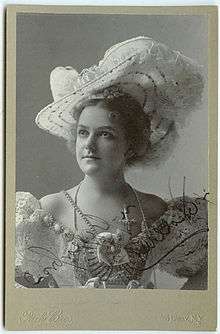Illustrated song
| Development of the music video | ||||||||||
|---|---|---|---|---|---|---|---|---|---|---|
|
|
||||||||||
An illustrated song is a type of performance art and was a popular form of entertainment in the early 20th century in the United States.[1][2]
Live performers (usually both a pianist and a vocalist) and music recordings were both used by different venues (vaudeville houses first and later in nickelodeons) to accompany still images projected from glass slides. This allowed the images to be painted in color by hand. A single song was usually accompanied by 12 to 16 different images that sequentially "illustrated" the lyrics. Projection booths used either stereopticons with two projectors or machines that combined projection of both slides and moving pictures.<ref name="Americanizing the Movies and "Movie-Mad" Audiences, 1910-1914">Abel, Richard (2006). A "Forgotten" Part of the Program: Illustrated Songs. University of California Press. pp. 127–134. ISBN 978-0-520-24742-0.</ref> Illustrated songs often preceded silent films and/or took place during reel changes, but some venues relied principally on illustrated songs alone. At least ten thousand small theaters nationwide featured illustrated songs.[3] Illustrated songs were seen as a valuable promotional tool for marketing sheet music. Audience participation was encouraged, and repeat performances also helped encourage sheet music sales.[1]

Several film stars began their careers as models who illustrated lyrics through a series of song slides. These stars included Roscoe Arbuckle, Fanny Brice, Eddie Cantor, George Jessel, Alice Joyce, Florence Lawrence, and Norma Talmadge.[4]
The first illustrated song was "The Little Lost Child" in 1894.[5] The song went on to become a nationwide hit selling more than two million copies of its sheet music, its success credited mainly to illustrated song performances which have been termed the first "music video."[3][6][7][8]
References
- 1 2 Abel, Richard; Rick Altman (2001). That Most American of Attractions, The Illustrated Song. Indiana University Press. pp. 143–153. ISBN 0-253-33988-X.
- ↑ John W. Ripley (1959). "All Join in the Chorus". American Heritage Magazine 10 (4).
- 1 2 "Music Video 1900 Style". PBS. 2004.
- ↑ Kally Mavromatis (1997). "Norma Talmadge - Silent Star of November, 1997". Monash University.
- ↑ Goldberg, Isaac; Gershwin, George (1930). Tin Pan Alley: A Chronicle of the American Popular Music Racket. Kessinger Publishing, LLC. pp. 141(376). ISBN 978-1417904532.
- ↑ Altman, Rick (2007). Silent Film Sound. Columbia University Press. pp. 107/462. ISBN 0231116632.
- ↑ Kohn, Al; Kohn, Bob (2002). Kohn On Music Licensing, 3rd Edition. Aspen Publishers. p. 141. ISBN 0-7355-1447-X.
- ↑ Marks, Edward B.; A.J. Liebling (1934). They All Sang: from Tony Pastor to Rudy Vallee. The Viking Press. p. 321.
External links
- Music Video 1900 style on PBS Kids Go!
- "Take Me Out to the Ballgame" on YouTube
- "'Goodbye, Girlie, and Remember Me' An Illustrated Song" [with video], Going to the Show.